If you ever googled “low-carb diets,” you probably noticed that keto and Atkins are at the top of search results.
Maybe you even stumbled upon some keto vs Atkins discussions across forums. This isn’t at all surprising. Both are low-carb, high-fat diets people follow to lose weight and improve health. Which probably leaves you wondering:
Is the keto diet the same as Atkins?

In the world of low-carb diets, keto is at the very end of the spectrum. In other words, it’s the king of low-carb. Atkins takes a more moderate approach to carb restriction, although it may not seem that way in the beginning. These two diets are also made with different effects in mind and have completely different histories.
Want to learn more about both to see which one is best for you?
Here, we talk about the many differences between keto vs Atkins in great detail. We’ll go over the science behind each diet, take a look at their different benefits, and offer suggestions for which one might be best for you.
Let’s Start with Atkins
Is the Atkins diet a ketogenic diet? Or is it something else?
Formally known as the Atkins Nutritional Approach, medical experts classify this low-carb diet as a fad even though it’s been around for half a century and despite the fact it was developed by a physician, namely Dr. Robert Atkins.
Dr. Atkins, who was a cardiologist, began developing his namesake diet, mainly for weight loss, in the late 1960s. After careful research, he published Dr. Atkins’ New Diet Revolution in 1972, a book that kicked off decades of debate within the medical community 1. There, Atkins explains what he knows about carbohydrates and sets the rules that shape the Atkins diet. Since the book’s publishing, hundreds of scientific publications have examined if low-carb diets can work for weight loss 2.
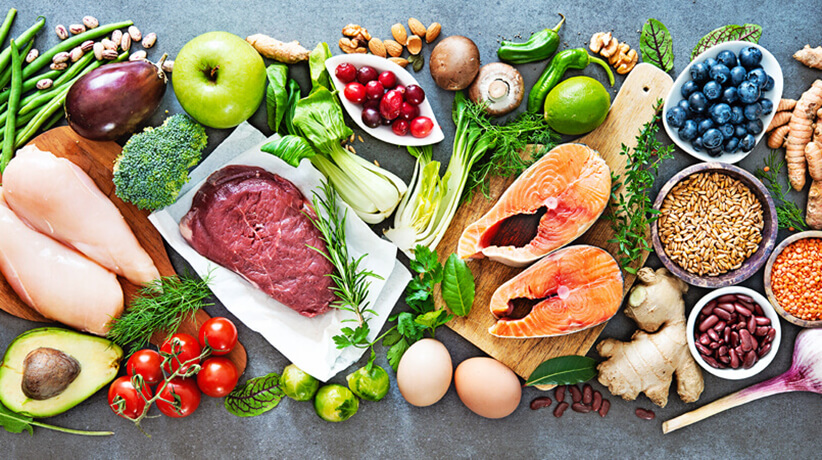
So, how does Atkins’ famous diet look like?
Like every low-carb diet, this one is based around eating fewer carbs and more fats and protein. Besides that, it involves several phases, beginning with a very-low-carbohydrate eating plan.
Here’s how it looks like in more detail:
Atkins: Principles & Types
Currently, there are two different Atkins plans available:
1. Atkins 20
This is the original Atkins diet and is best if you want to lose weight quickly or have a lot of weight to lose.
| Atkins 20 has 4 phases: | |
| Induction Phase – Eat only 20 grams of net carbs a day or make carbs 10% of your daily calories. Low-carb vegetables like broccoli, cucumbers, celery, and green beans are best to keep carbs low. Make sure to include protein foods like fish, chicken, eggs, and tofu with every meal and eat as much fat as you can. Drink around 8 glasses of water and avoid alcohol. | Timing: Follow this phase for the first 1-2 weeks. |
| Balancing Phase – Time to start introducing moderate-carb foods back into your diet. Berries, nuts, and seeds are great options. Continue eating mostly low-carb vegetables and avoid high-carb foods like cereals and legumes. The balancing phase is when you should start tracking your weight loss to see when it’s time to move on to the next phase. | Timing: Stay here until you’re about 10 pounds away from your goal weight. |
| Pre-Maintenance Phase – You can now start reintroducing high-carb but nutritious foods like fruits, starchy vegetables, and whole grains. You’re allowed to eat an additional 10 grams of net carbs per week. But in case you notice you’re not losing weight, cut back on the carbs again. | Timing: Stay in this phase until you reach your goal weight or go back to the balancing phase if staling. |
| Lifetime Maintenance – Once you’ve reached your goal weight, you can jump to this phase. As the name suggests, it should last a lifetime, that is if you want it to. To maintain weight, eating around 100 grams or less carbs is best for most people. | |
2. Atkins 40
Atkins 40 is the newer and simpler version of the classic Atkins diet. Its main principles are portion control and limiting net carbs to 40 grams daily. This one is best for people who need to lose only a little bit of weight. It’s also safe for pregnant and breastfeeding women because food choices are less restrictive.
Another great thing about Atkins 40 is that it does not come in separate phases, making it relatively easy to follow.
Feeling interested?
Start your diet with a limit of 40 grams daily net carbs. Then, add 10 net grams of carbs each week once you are 10 pounds away from your target weight (however, this is purely optional).
And as if that wasn’t enough, Atkins 40 allows for moderate alcohol intake (equivalent to one drink per day). Now you won’t have to skip Margarita Day.
3. Modified Atkins
Modified Atkins is very similar to keto. It’s called “modified” because it limits carb intake to a maximum of 20 grams per day, separating it from its classic cousin. And just like keto, you don’t need to watch your calories on this version.The only feature that sets it apart from the keto diet is that it allows for high amounts of protein.
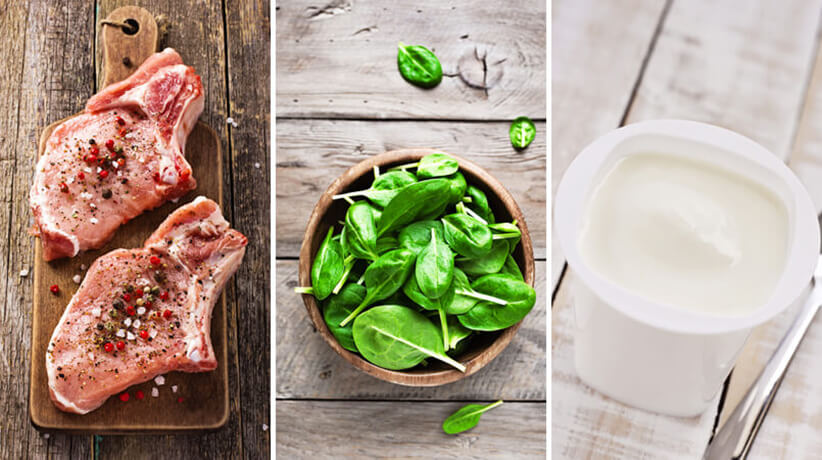
What the Atkins Diet Looks Like
Your meals on the Atkins diet should consist of:
- Meat: Any type of meat will do, but unprocessed fresh meat is best.
- Fish: Fish and other seafood are good sources of protein and essential omega-3 fatty acids.
- Vegetables: Low-carb vegetables like broccoli and spinach are important early in Atkins. Later, you can also add starchy vegetables such as potatoes, corn, and parsnips.
- Full-fat dairy: Butter, cream, aged cheese, and full-fat yogurt are high-fat staples in the Atkins diet.
- Eggs: A great source of both fat and protein, eggs also provide the additional benefits associated with omega-3s.
- Nuts and seeds: Almonds, macadamia nuts, walnuts, and sunflower seeds are all great choices.
- Healthy fats: Cold-pressed oils like olive oil and butter are preferred on Atkins.
Do not eat:
- Sugars: All types of sugar are no-no on Atkins. This includes honey, agave nectar, and foods or beverages sweetened with sugar.
- Refined oils: Avoid refined oils such as sunflower, soybean, and corn oil. These are high in omega-6 fatty acids (not to be confused with omega-3s), which are sometimes linked to inflammation, making weight loss difficult.
- High-carb vegetables and fruits: Potatoes, carrots, turnips, bananas, apples, and mangoes are some examples. Once you reach the pre-maintenance phase, you can enjoy these in moderation.
- Grains and legumes: Both are exceptionally high in carbs, so don’t even look at them.
- Trans fats: Partially-hydrogenated oils and some margarines have unhealthy trans fats, which are linked to cardiovascular diseases. You definitely don’t want that.
|
Sample meal plan (after induction phase) |
Breakfast: A bowl of steel-cut oatmeal made with full-fat milk, topped with fresh blueberries. |
| Lunch: Apple muffins made from almond flour and pecans, sweetened with stevia. | |
| Dinner: Beef stroganoff over whole-wheat noodles with steamed broccoli on the side. |
About the Keto Diet
A low-carb diet that’s been in the spotlight for a decade or so is keto, which is also a high-fat, adequate-protein diet.
However, it’s been around for much longer than that.
The main difference between Atkins diet and ketogenic diet is ketosis: a metabolic state of enhanced fat burning and elevated ketones that can replace glucose as fuel for energy.
Researchers developed the ketogenic diet (aka keto) in the 1920s to manage severe epilepsy in children, after studies found that limiting carbs causes ketosis, a known cure for epilepsy. It’s only recently that keto became popular for weight loss and better health.
But now you’re probably wondering, what’s the difference between a low-carb diet and a keto diet?
The main difference is that it causes ketosis — a metabolic state of enhanced fat burning and elevated ketones. Ketones are a compound that can replace glucose in many chemical reactions in the body, like serving as fuel for energy. The keto diet, ketosis, and ketones help with weight loss but also things like better brain health and a lower risk of heart disease and type 2 diabetes 3,4.
Other things keto can do for you include:
- Enhance mental clarity
- Improve energy levels
- Better manage or even reverse type II diabetes
- Prevent some types of cancer
- Control your appetite; and
- Increase longevity
Like Atkins, the main principle of keto is carb restriction followed by higher fat intake. But there are many, many more intricacies to this diet.
Keto Diet Principles & Types
Be warned that the keto diet is strict, especially when it comes to macronutrient ratios (macros).
Keto macros are based on research that shows your metabolism changes drastically when you eat less than 50 grams of carbs daily 5.
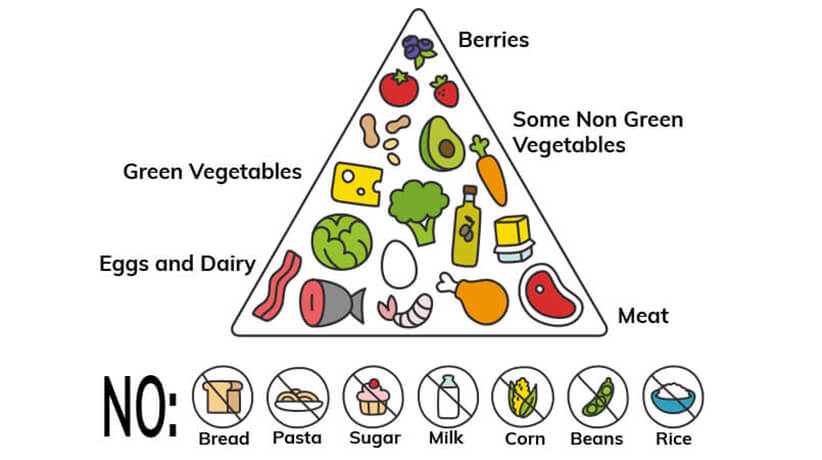
Photo by Shutterstock.com
Here’s how they typically look like:
- Carbs: 5-10% of calories
- Protein: 20-30% of calories
- Fat: 65-80% of calories
Eat this way and you’ll be in ketosis within a few weeks.
But how exactly does eating a certain way lead to ketosis?
Not enough carbs in your diet leads to drops in circulating insulin. In turn, decreased insulin brings about metabolic changes that discourage fat accumulation in the body. Besides that, after just a few days on keto, your glucose stores are too depleted to fuel the brain or other organs, so your body produces ketones as replacement fuel.
But ketosis is not the end goal of keto.
What you want to aim for is keto-adaptation, which is essentially your body becoming perfectly adapted to running on fat and ketones. What this gives you is consistent and long-lasting energy, an ability to maintain normal weight, and metabolic flexibility (which can make weight loss easier).
And now onto keto diet types:
- Standard keto diet: This is the original version based around macros mentioned earlier. It provides health benefits such as weight loss, blood glucose control, and increased energy.
- Cyclical ketogenic diet (CKD): Developed for bodybuilders and athletes on high-intensity training regimens, cyclical keto involves periods of carb-loading “re-feeds” (50 gram of net carbs, 5 days a week) and carb-loading days (up to 600 grams of carbs, 2 days a week) in addition to following a standard keto diet.
- Targeted ketogenic diet (TKD): Targeted keto is eating your daily carb allotment 30 minutes before or after workouts. This version is ideal for endurance athletes or people who work out at a moderate intensity on a daily basis.
- High-protein ketogenic diet: High-protein keto allows for a slightly higher intake of protein (about 5% more than standard keto). However, the amount of protein you consume daily still needs to be low enough to keep you in ketosis.

What to Eat on Keto
Despite what you may have heard, there’s more to keto than eating bricks of butter with bacon on the side.
Here’s what delicious and nutritious food keto encourages:
- Fatty cuts of meat: Beef brisket, beef ribs, T-bone steak, sandwich steaks, and ground beef (look for 75-80% lean or lower) are good options.
- Fatty fish: Salmon, mackerel, sardines, and herring can help boost your omega-3 fatty acid intake and protect your cardiovascular health and brain.
- Full-fat dairy: Butter is a keto staple, but cream, cheese, and full-fat yogurt are also great.
- Low-carb vegetables: Broccoli, cauliflower, spinach, cabbage, and asparagus are good examples. These will help you get essential vitamins and minerals as well as fiber.
- Berries: Berries tend to be low in carbs, high in fiber, and high in antioxidants. Some keto favorites are blueberries, boysenberries, and raspberries.
- Healthy fats: Olive oil, coconut oil, avocado oil, butter, and lard are all great on a keto diet. Avoid sources of trans fats such as refined oils and margarine.
- Substitutes: Almond flour, coconut flour, coconut milk, almond milk, and stevia can replace high-carb ingredients to bring versatility to your keto meals.
|
Sample meal |
Breakfast: Mushroom and feta omelet with full-fat yogurt. |
| Lunch: Tuna salad served on keto bread with a side of fresh blackberries. | |
| Dinner: Garlic butter chicken with asparagus on the side. |
Keto vs Atkins
So, is it keto better than Atkins or vice versa?
Truth be told, both diets have their pros and cons, so it’s really not a question of which diet is better as much as which diet is better for YOU.
If you’re feeling ambivalent about these diets, here’s a comparison of the two.
Similarities & differences
Keto vs Atkins #1
The induction phase of the Atkins diet is almost the same as keto. Carbs are kept low, so you’ll likely enter ketosis. Whether or not the induction phase of Atkins will lead to ketosis depends on your protein intake.
Keto vs Atkins #2
Studies show that both of these diets cause weight loss 6,5. However, research tends to favor keto, concluding that it provides more effective weight loss compared to Atkins. Since Atkins allows higher carb intake during later phases, the long-term metabolic changes associated with keto are not present, so your body continues to burn carbs for fuel.
The keto diet, on the other hand, means sticking to 30 grams of net carbs per day, turning your metabolism into a strict fat burner long-term. On the other hand, the higher carb and protein intake in the later phases of Atkins makes it more sustainable than keto for some people.
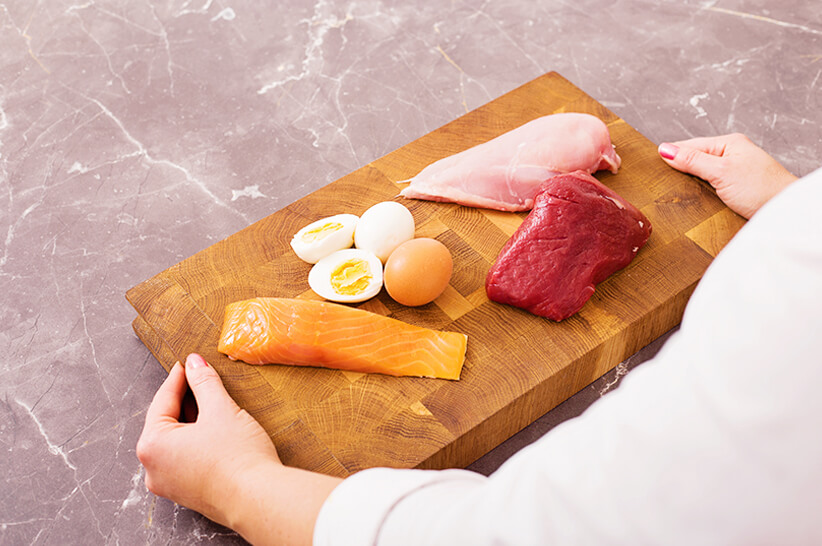
Photo by Shutterstock.com
While Atkins is a low-carb diet and keto is a high-fat diet, both focus on unprocessed foods.
Keto vs Atkins #3
Atkins is primarily a low-carb diet, while keto is more accurately a high-fat diet. There’s great emphasis on fat intake on keto — in fact, up to 80% of your calories should come from fat on a keto diet, compared to 20 to 30% on other diets 7. The Atkins diet is also higher in fat than your typical weight loss diet, but not as much as keto.
Keto vs Atkins #4
Both diets focus on unprocessed foods. This is both for practical and health reasons. When you eat real, whole foods, it is much easier to estimate your macro intake. Unprocessed foods are also higher in valuable nutrients that support your health and keep potential deficiencies at bay (unlike more restrictive diets).
Keto vs Atkins #5
You need to avoid sugar, honey, and nutritive sweeteners on both diets because they tend to affect blood glucose. Instead, stevia and erythritol are good sweetener options. Both are non-nutritive, meaning they don’t contain calories (or contain a negligible amount) or affect blood sugar.
The Final Verdict
As you can see, both diets have their benefits and setbacks.
Still, a lot of people wonder, do you lose more weight on keto or Atkins?
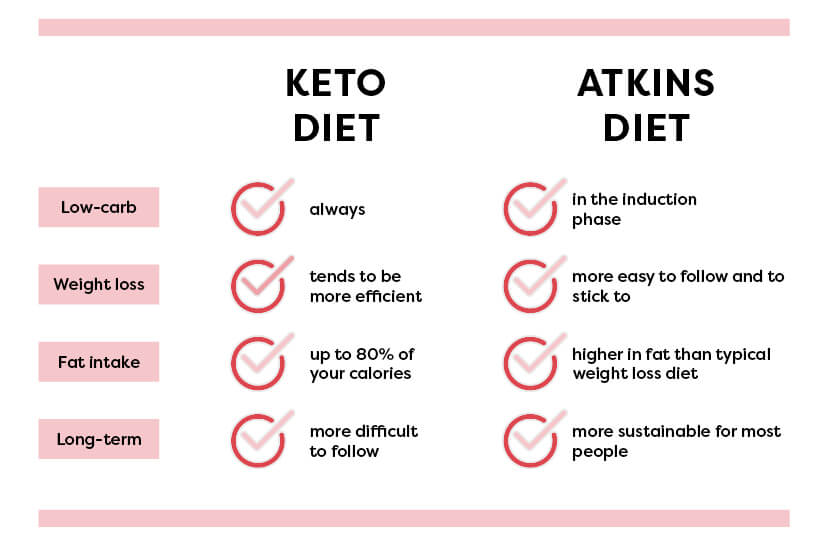
Where research is concerned, keto may have a slight edge when it comes to weight loss. Keto can help you boost cognitive functioning, control (and sometimes even reverse) diabetes, and even help to prevent or fight cancer 8. There are also more studies showing keto is safe long-term 9,10. Unfortunately, there aren’t near as much studies on Atkins, but this is because it’s not used in the clinical setting like keto.
Despite the lack of research on Atkins, what we do know is that it’s more sustainable for most people, while keto is notoriously difficult to follow.
Takeaways
Keto vs Atkins: it’s a difficult question to answer. Both diets have their pros and cons. Current research shows that keto tends to be more efficient than Atkins for weight loss, but keto is also difficult to stick to, so Atkins provides a sustainable alternative.
The efficiency of Atkins also depends on your metabolic flexibility and goals. If you are able to effectively switch between burning carbs and fat for fuel, then Atkins may be ideal for weight management in the long run. Atkins also allows for more carbs, so you’ll find eating at restaurants easier and have a wider range of food options to choose from.
In the end, whether you should opt for keto or Atkins depends on how willing you are to stick to low-carb eating, as well as your metabolic flexibility. Keto is great in terms of efficiency, but some people find that a life without carbs is unbearable. If you’re still undecided, we suggest switching between keto and Atkins and finding what works best for you.




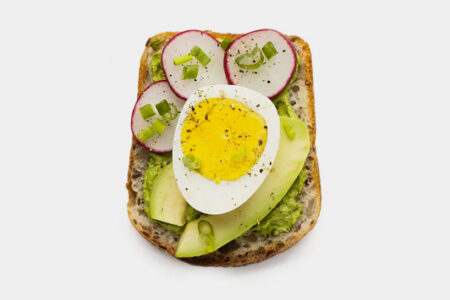
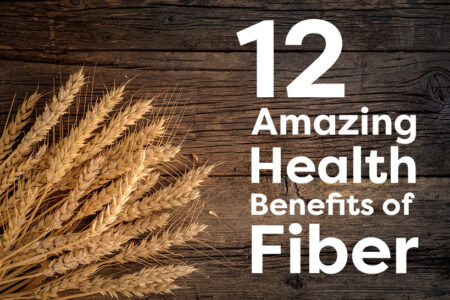




![Juicing for Weight Loss: Everything You Need to Know [Plus Recipes]](/wp-content/uploads/2019/08/Juicing-for-Weight-featured-image.jpg)










